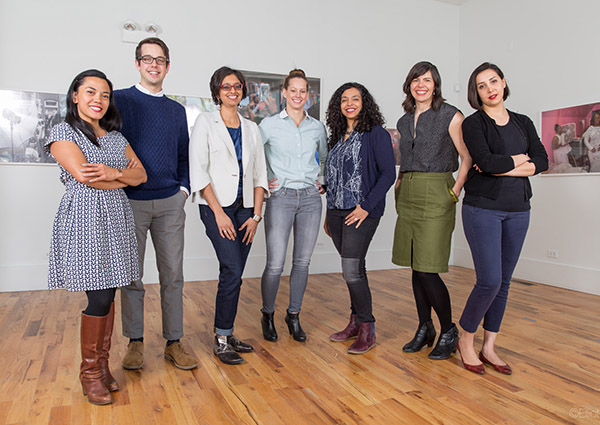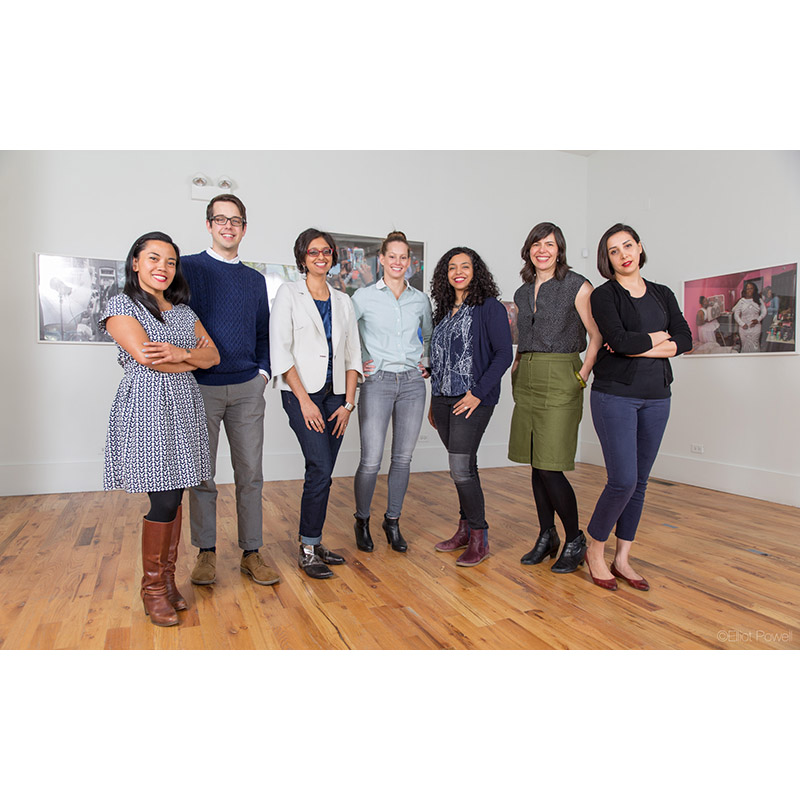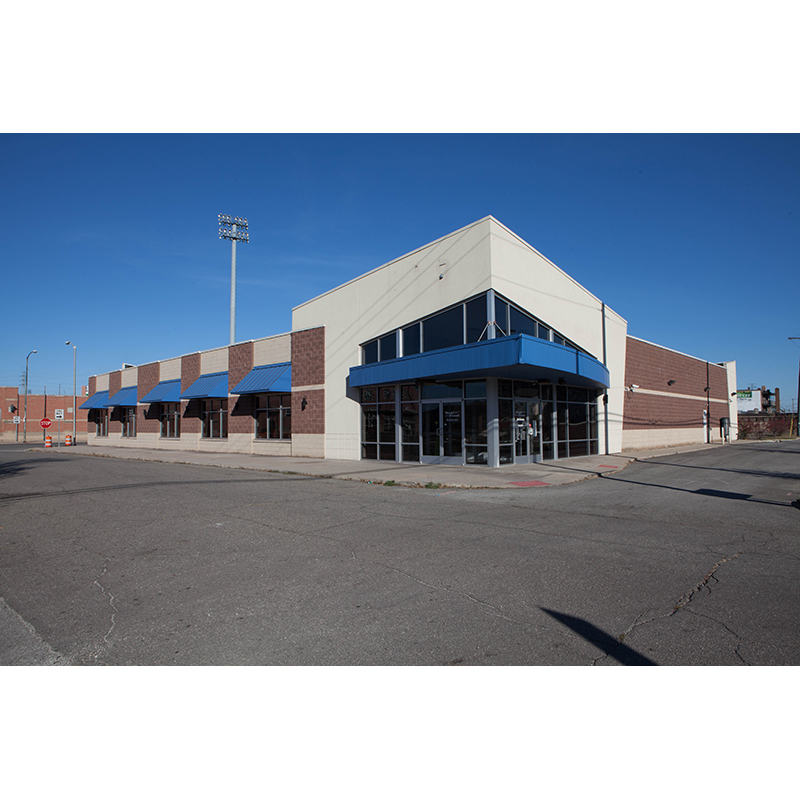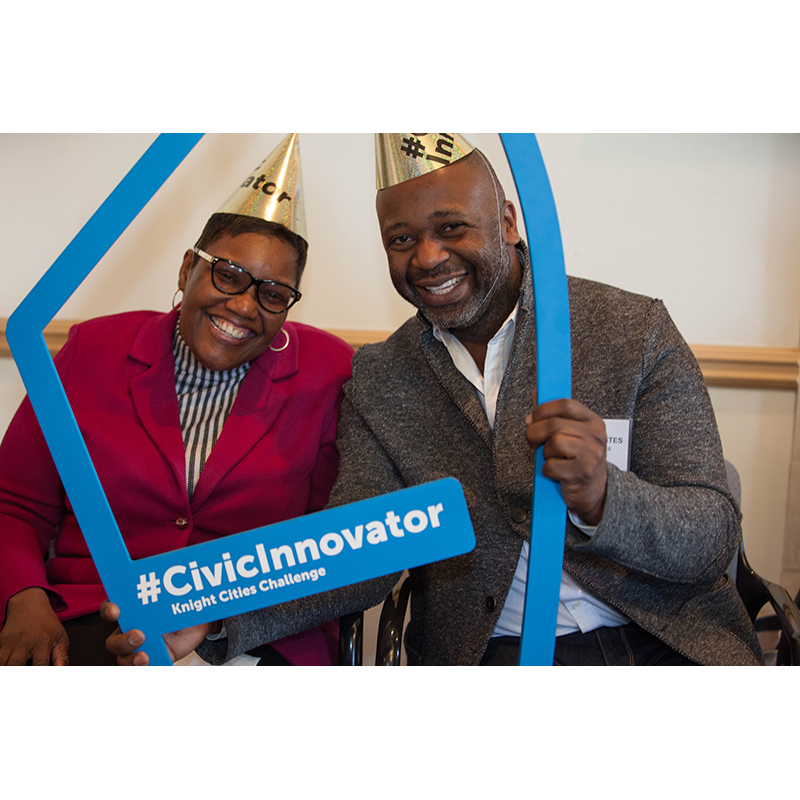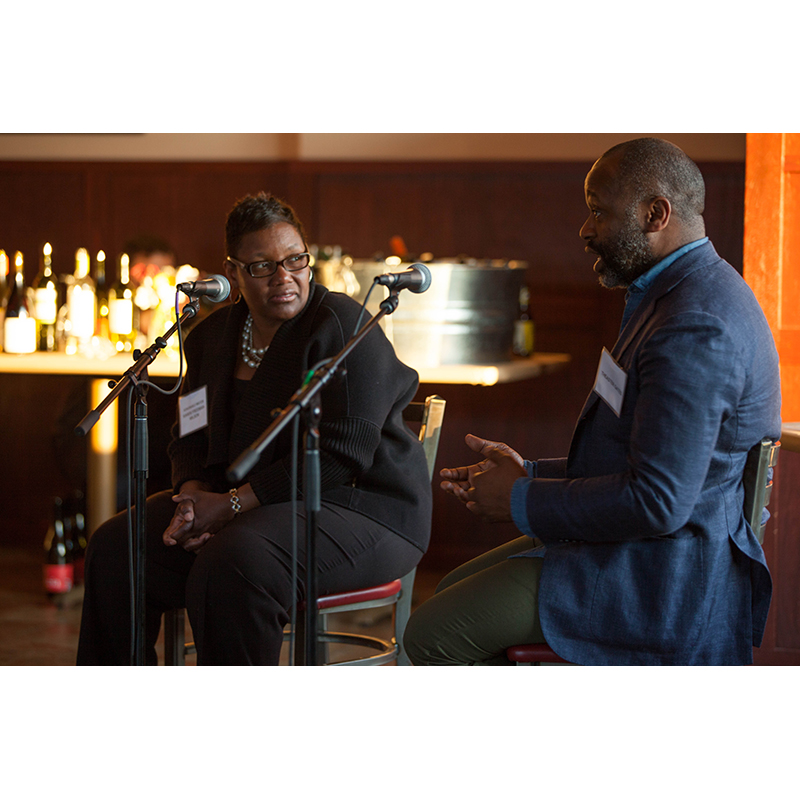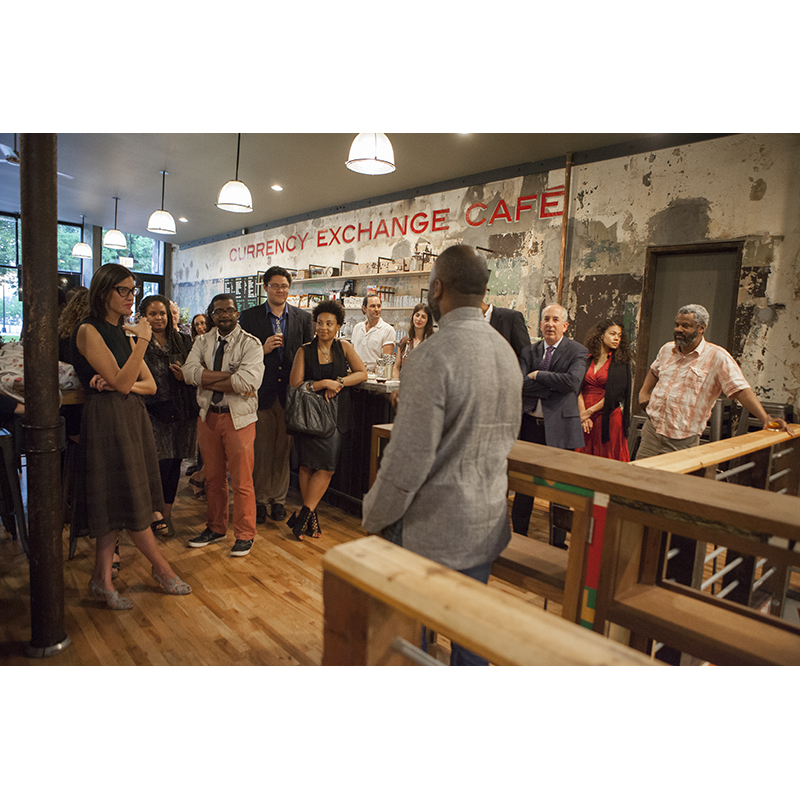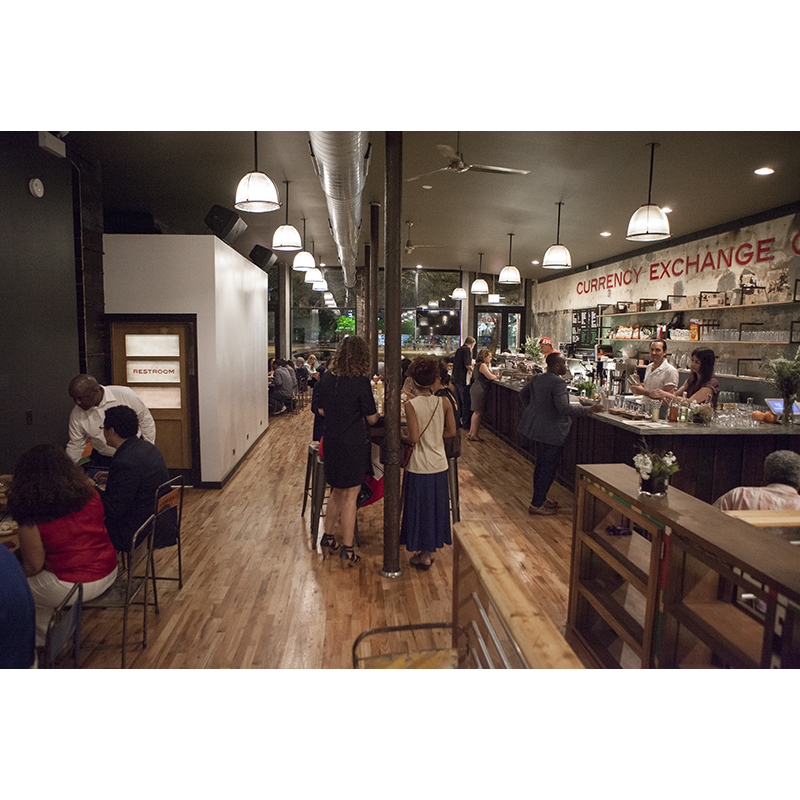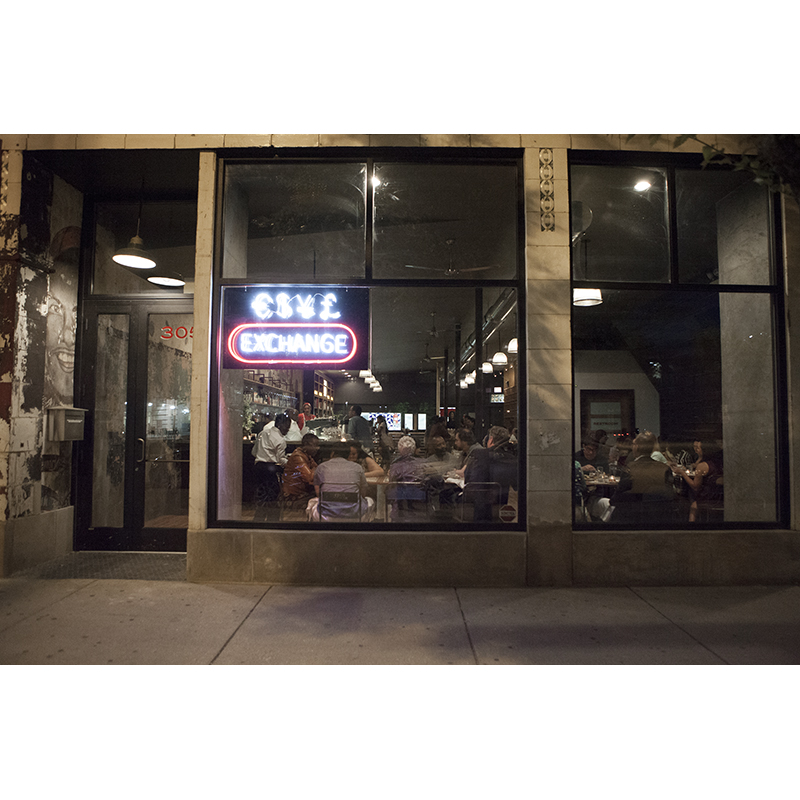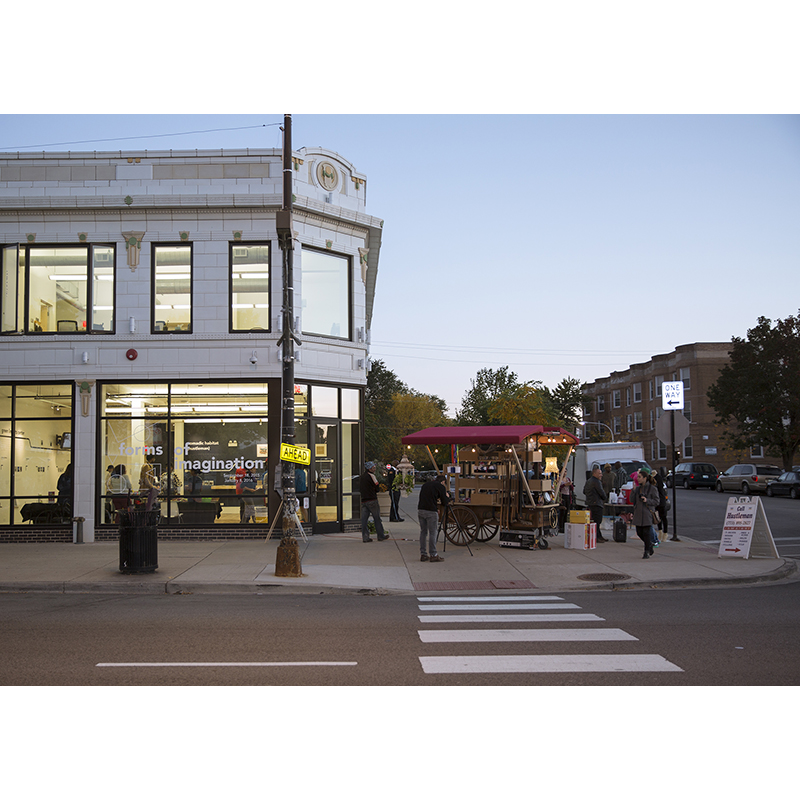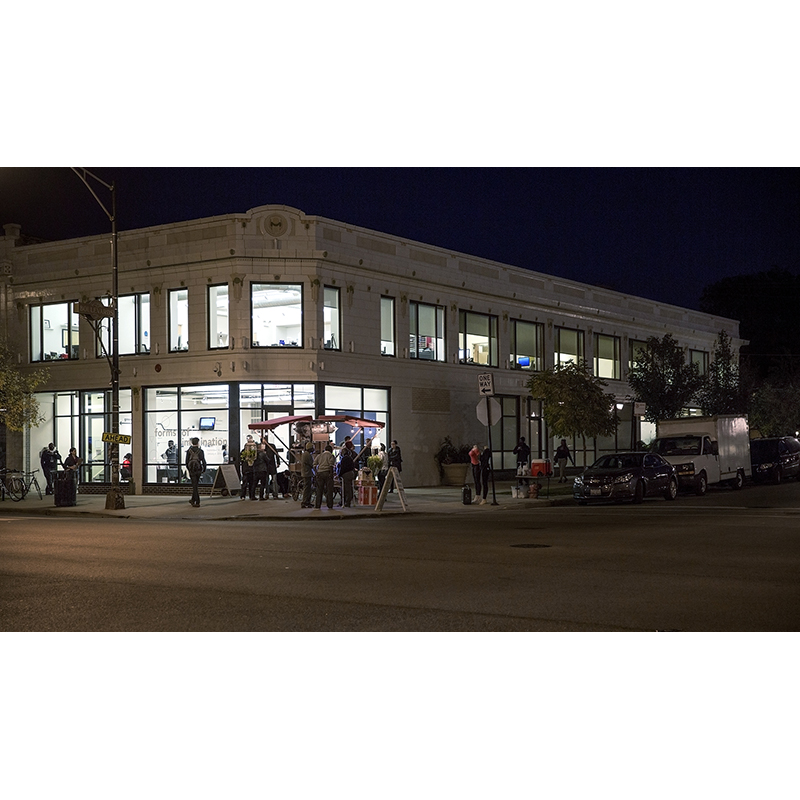Theaster Gates, one of America’s most famous living artists, originally trained as a potter, produces work that gracefully fuses art and activism. Much of what Gates creates, the vessels and the sculptures, reverberates deeply with his own experience as a black man growing up in Chicago. But for many, the fullest expression of his practice happens in Chicago’s Greater Grand Crossing neighborhood, where, since 2008, he has paired the work of making objects with the work of transforming buildings, blocks, and entire districts. The Archive House, for instance, is now composed of colorfully stained boards, mosaicked together, and contains a landscaped garden and a long, recycled wood table, though at a distance it’s virtually indistinguishable from other buildings on the block. This place is not an oasis from that which surrounds it; it’s a beautiful expression of the materials that are everywhere in Greater Grand Crossing. Unlike the pre-fab utopias that are so often parachuted into struggling neighborhoods, Gates’s renovation projects incorporate the history of a place and the people who have spent decades creating community there.
Efforts of social change have always involved charismatic leaders whose names become synonymous with the movements they usher in, and in art, too, pieces regularly bear the signature of a single creator when dozens are bringing the creative dream to life. Behind the scenes of Gates’s revitalized spaces and workshops, a cadre of programmers, artisans, and others are laboring to help conceive and enact a vision for this city—and others in the United States. Place Lab, a project funded in 2014 by the Knight Foundation under the auspices of the University of Chicago’s Arts + Public Life initiative, is peopled with professionals from across the disciplines and tasked with translating Gates’s idea of urban America to nearby Akron, Gary, and Detroit. The Place Lab team operates within the daily grind of activism: writing contracts, attending city council meetings, creating connections with communities, making sure buildings are up to code. “We aren’t a think tank, we’re really a do-tank,” explains Nootan Bharani, one member.
Despite his successful solo practice and his magnetic presence at the helm of Place Lab, Gates has long rejected the role of singular genius that many funders, curators, and city officials would have him play. “Within my artistic practice and especially in my space-based work,” Gates says, “I’ve hired a team whose capacities, passions, and deep desire to build spatial and cultural equity are as strong as mine. In these situations of leadership, the best thing I can do is make room for other people’s talents.”
Through a commitment to both art and bureaucracy, to the magical and the mundane, Place Lab tackles gentrification, segregation, de-industrialization, and the systemic neglect of the Midwest’s major cities. Recently I spoke to three of its members over Skype: Lori Berko, a real-estate attorney and the COO of Place Lab; Nootan Bharani, an architect and lead design manager; and Isis Ferguson, an activist and cultural organizer and the team’s program manager. The versatile group also includes an urban planner, a construction manager, and an administrator. Together we discussed ethical redevelopment, dancing around gentrification, and why, in Ferguson’s words, “every single community doesn’t need a Theaster in order to have transformation.”
—Heather Radke for Guernica
Guernica: What exactly is Place Lab?
Isis Ferguson: It’s hard for us to have an elevator speech because we are the kind of entity that has really previously not existed. We don’t fit into the language that everyone else uses [to describe us]. So can I tell you what we are not, as a way to tell you what we are?
Sometimes when people want a go-to, they describe us as an urban think tank. We try to resist that because it feels very removed from the people in the neighborhoods that we are in. And we think of ourselves much more as the implementers and observers and documenters, as opposed to just the people in the ivory tower thinking about neighborhoods and then making policy.
Lori Berko: The team is comprised of areas of expertise. We have everything from law to urban planning to architecture to arts and arts management. Isis is a cultural worker. It is really a diverse team. I think the thing that is so unique is that I get beyond the things I would think about in my traditional practice [as a lawyer]. We are all learning and utilizing each other’s skill sets.
That is what we were originally tasked with doing: writing [Gates’s] secrets out.
Guernica: When Place Lab started, what need were you responding to?
Lori Berko: In the philanthropic and artistic world, Theaster is magic. He is the “secret sauce.” [Many people think] that only he can do these amazing redevelopment projects in certain neighborhoods. So what [the funders] wanted to do was get Theaster’s magic on paper. That is what we were originally tasked with doing: writing his secrets out.
So [they asked us to do] case studies [rather than] a lot of demonstration work, although that was in our grant too. And we really fought against that and said, you know, this is a process. What is important is to note the process of redevelopment in Chicago and other communities so we can take certain principles that we have learned by studying, and share [them].
Guernica: Last weekend I was spending some time with a curator who had Gates speak in Detroit. And she asked me, “How can we just replicate Theaster all over the world?” How often does that come up for you and what is your response to that question?
All: It comes up every day.
Isis Ferguson: It comes up all the time, and there is no use in getting frustrated about it. There is always a cult around particular personalities, so I understand why attention is paid to Theaster and why people will sort of push aside the methodical, practical parts of his work and just see wonder and magic, and be invested in his work as this thing only he can do. When people ask us about replicating, we respond that every single community has people with ideas. Every single community has folks with money. Every single community doesn’t need a Theaster in order to have transformation. In fact, it would make no sense to replicate him, because the contexts are different, and the histories are different. Theaster is a West Side Chicagoan responding to Chicago-specific issues. And he is an artist thinking about space and race and blackness. That is not the same thing as what’s happening in Tucson or Cleveland or wherever. And so customizing models or processes that seem useful to many communities makes a lot of sense. Replicating does not.
Nootan Bharani: We are working to shift a paradigm. We are working to shift to a world where arts and culture drive development. That is the thing that should become replicable, not the person.
Guernica: What is the theory of ethical redevelopment? Talk me through how you apply that theory to these different projects.
Lori Berko: We call it mindful city building. It’s a way to move beyond the business-as-usual commercial developments where “the bottom line is the top priority.” It’s an alternative way to look at development. It avoids displacement. It contradicts gentrification.
Nootan Bharani: Ethical Redevelopment is a programming series that is starting in June with a large gathering with community stakeholders. Then we will host nine salons which are membership-based, essentially by invitation only. There will be a final piece at the end, in the middle of 2017. So it goes from June 2016 to June 2017. The series is based on the nine principles of ethical redevelopment, which are at the foundation of all this work. We derived the principles from listening to the people that have been in some way impacted by Theaster.
Isis Ferguson: It is both a programming series and a strategy, so the title is also the content. It is an opportunity to gather colleagues and thought leaders—not necessarily well-known thought leaders, but the residents, artists, entrepreneurs, bankers, organizers, activists, architects, developers, designers, and planners in communities who are attracting talent and expanding economic opportunities.
It’s a time for us to be self-reflective; we are asking folks to think about their work through the strategies they need to develop. The idea is that as a member or a participant, you’re presenting a project [for which] you will identify the challenges. And we will have experts in the room to directly respond to moments when you are having an engagement issue or haven’t been able to get funding, or are having a building zoning issue. What we are hoping is that it can be a launch pad to move the work forward.
Greater Grand Crossing is not Pilsen, nor is it Wicker Park, nor is it Hyde Park. It is a South Side, predominantly African American neighborhood.
Guernica: What does “gentrification” mean to you and in what way is the work you are doing a response to it?
Isis Ferguson: I think it’s the elephant in the room. And for legitimate reasons maybe it seems like we dance around the conversation. But it’s like a vacuum. Every conversation we have could just be a conversation about gentrification. I don’t want to say we try to circumvent it, but we try to dial back a little bit and take a more comprehensive view.
We were with [University of Chicago] Harris School of Public Policy students the other day, and I heard Theaster kind of flippantly say, “Arts and culture is not the reason that neighborhoods gentrify. That is not actually what is happening.” That flies in the face of a lot of thought around [gentrification]. A lot of articles and data [suggest] that an area is not of interest to a lot of people and then artists move in and create a buzz. And the buzz is so big that not only can they no longer afford to live there but the folks who have lived there cannot stay.
The work that we are doing in Chicago in particular is not in neighborhoods that are on the cusp of an incredible transformation. We are in communities facing very difficult realities—population loss, high unemployment, some blocks with more vacancy than inhabitants, violent “territory-related crime” that is connected to turf-based drug trade and shootings. People are not fighting to move there. Greater Grand Crossing is not Pilsen, nor is it Wicker Park, nor is it Hyde Park. It is a South Side, predominantly African American neighborhood. And so gentrification, while it’s not something we ignore, seems to be a little further down the road. And because we are not employing traditional development tactics, it likely won’t be the result. This is a group of folks cognizant of power and privilege and race and history, so we are forefronting that in the conversation now, and not waiting until the neighborhood changes in three years to think about it.
Lori Berko: Although it’s not the forefront and it’s not an emergency, in all the conversations with the city and other organizations where we are trying to create partnerships, we are asking: How can the community as it exists benefit not only from the Stony Island Arts Bank and the Cultural District, but also how can it be part of the conversations for housing, for businesses?
[For a lot of small neighborhood businesses] a $7,000 break of a stove or a refrigerator would kill their business. The only financing that is available to them is at an extremely high interest rate. They don’t qualify for conventional financing, and rely on all these alternate measures to even keep their business afloat. So as we are doing this development, I wonder how can that be threaded through this conversation. It’s what we are hoping ethical redevelopment will bring. It will bring people who are doing traditional development also—the mom-and-pop shop, the local business. How can everybody be in the same conversation? These things can be worked out on the front end. If they are a focus on the front end, instead of a reaction, we can be proactive about [gentrification].
Nootan Bharani: Gentrification to me is one of the results of allowing rampant, unethical redevelopment. So the whole idea of ethical redevelopment is addressing gentrification by its very definition. In some ways it’s the elephant in the room, but at the same time the whole thing is about gentrification. It’s what we are always talking about.
Beautiful objects come from and belong in blighted spaces, just as they do in high-investment areas of a city.
Guernica: How have you applied, or how do you plan to apply, the principles of ethical redevelopment to a project in Akron, Detroit, or Gary? What are the goals? Who did you work with? Where do the principles apply and where do they falter?
Isis Ferguson: ArtHouse: A Social Kitchen, in Gary, Indiana, is an evolving, dynamic space for art, artists, culinary entrepreneurs, residents, and visitors. The concept was really just to respond to the needs of Gary’s landscape at a cultural, economic, and architectural level. The question we asked ourselves was: What is in our repertoire that has the potential to catalyze activity with and for Gary? The answer: adaptive reuse of an underutilized facility that has both art and economic imperatives.
Everyone deserves to see and be a part of the transformation of their spaces into places. Beautiful objects come from and belong in blighted spaces, just as they do in high-investment areas of a city. Creative people can play a pivotal role in how this happens. We are offering design interventions and connecting with local fabricators and construction teams to drive the design work.
Letting the building tell us what moves to make is going to be crucial to the success of the project. The building needs renovation but we must be strategic about what to take on. Instead of imagining a project in its entirety, more can be achieved when discrete smaller projects are carved out of one larger project. In the case of ArtHouse, we’ll focus our interventions on a culinary program that provides shared access to members and affiliated caterers, designating zones of the kitchen and the rest of the building as a training space, and granting access to areas of the kitchen for culinary business entrepreneurs to pilot restaurant concepts.
We do not have the luxury of time, which is often the case with grant-funded projects. We have two years and we are already a year in. A sense of place cannot be developed overnight, so the work we do at ArtHouse and the infrastructure we build for ArtHouse is intentionally catalytic. Ultimately, we need Gary the city and Gary residents to make the idea sustainable or adapt it so that it can exist well after the grant timeline concludes.
Guernica: As I understand it, your work is concerned with insiders and outsiders, with who gets to be in what conversations. I imagine that going into Gary or Detroit or Akron, you might feel like outsiders. But there are other times when you might feel like insiders: within the arts community, or working with boards and in city government. How do you navigate your sense of belonging in these spaces?
Nootan Bharani: In certain situations in Chicago, Theaster has this position of being able to leverage information and access for those who don’t always have it. And so just being that conduit, being that translator, is really key. In Chicago, it’s becoming more and more known that we have that leverage, because clearly there is more and more work that is happening and people are seeing that. In the other cities, we are [now] doing the same thing. We are working between [groups of] people, allowing information to flow both ways, because it’s really surprising to learn and understand how little, say, city halls really know about their people and about their neighborhoods.
Isis Ferguson: People let you know really quickly if you are a known entity to them or not and if they want to engage with you in a trustful way based on your reputation, or if you have to prove that you are the right group with a solution that would make sense. I think we negotiate that as well as we can, always keeping in mind that we aren’t here to parachute any solutions. In fact, we aren’t thinking of solutions. We are much more interested in asking different questions, as an artist-led entity, than in providing prescriptive models. And I think that when the work feels the most exciting it’s because it’s the most collaborative and it’s clear we’ve earned that trust.
Guernica: The murder rate in Chicago is up by 84 percent this year. The state of Illinois has once again failed to pass a budget. How does Place Lab grapple with these urgent problems? Do you feel like you have to balance the need to think about long-term utopic visions and these critical, acute urban issues?
Nootan Bharani: On a daily basis, Place Lab is not thinking utopically. We are on the ground, bringing definition or clarity to the problems—maybe demonstrating the limits and possibilities of policy. We aren’t a think tank, we’re really a do-tank.
Isis Ferguson: On a basic level, Place Lab and other entities in Theaster’s ecosystem [Arts + Public Life and Rebuild Foundation] are creating places of public assembly, which means we are deeply concerned with disparity of resources and quality of life in the places where our work lives. How can we make culture happen so that it enhances neighborhood vibrancy and livability? That is practical; that is connected to murder rate, state budget crisis, and school cuts. It’s not utopic to create what you want to see, to rebuild instead of articulating what you are against. You also have to go on record, in actions and in words about what you are for.
[It’s about] living in and next to well-designed buildings that signal to all who pass or enter that this place matters and that the people in, of, and around the building matter too.
Guernica: In his interview with Carol Becker in the Phaidon book, Gates talks about the joy and innovation in his art practice as a gift of his own blackness. I wonder if you see Place Lab as having a unique take on race in the worlds of urban planning, art, or placemaking.
Isis Ferguson: Race is often explored or talked about in institutional settings as something to contend with. I don’t connect with that and I don’t think that’s a strategy or practice of Place Lab. Race is something that is lived and experienced.
So I understand Theaster’s recognition of blackness as a gift. Blackness is a gift in so many ways. There is joy felt in connecting to a legacy, to a people who have simply gotten it done, made it happen, survived and felt a deep sense of social cohesion. [Black] people have demonstrated care and a responsibility for impacting the quality of life of those around them, whether those people are related, next door, or down the block. Theaster’s work stripped down is about an individual who has an artistic vision and a desire to live in a place and contribute to the cultural, economic, and architectural landscape of that place—not to do this in isolation but to create platforms for people to do this and to expand possibilities. It’s the “not in isolation part,” the “for us and not just for me,” that feels like a black cultural practice—a practice that I understand is something shared among lots of marginalized communities, regardless of location.
It would be ridiculous and irresponsible to overlook the racial dynamics operating at the nexus of creativity, urban planning, and neighborhood transformation. It’s implicit. So many communities have experiences of policy and urban planning as forces that enact inequality. People have lived in places that are intentionally neglected precisely because of who resides there. So why wouldn’t solutions for the city be rooted in cultural expression? Why wouldn’t forms of redress be rooted in race, gender, and class? We are doing work that is about people in place. This is race work. This is about bodies moving freely, having access, being engaged, being the creators of beauty and the recipients of it as well. [It’s about] living in and next to well-designed buildings that signal to all who pass or enter that this place matters and that the people in, of, and around the building matter too.
Guernica: What about gender? Do you think race and gender need to be considered in new ways in these broader conversations about the future of cities?
Isis Ferguson: Innovation, city-building, and gender have a relationship too. A number of urban institutes, foundations focused on urban affairs, or even funding sources for “urban issues” tie resources to identifying the most innovative solutions to a complex set of ideas. Men’s work very often gets held up as innovative. Historically, men have been placed in roles where they were the city builders and the policymakers. Place Lab is a team heavily dominated by women and I often attribute our insistence on process, not just outcome, to be both a dimension of our academic fields but also of our gendered approach to strategizing and operating. I don’t think the newest idea is always the sharpest.
Women have held down households and held communities under siege together in numerous historical moments. But women’s work reads as simple or whatever the opposite of innovative is. The kinds of things women do to stabilize communities can be drudge work. It’s [these] labors of love that keep traditions alive and communities afloat. Women’s work is so normalized that it becomes invisible; I want to shift this so that women can be seen as the architects and builders and innovators of communities too.
There is something troubling about innovation that makes me hesitant to embrace it [but] it’s not a rejection of change. As a team we are committed to developing approaches for artist-led, culture-focused work that creates impacts on residents and neighborhoods. We are invested in the agency of those around us. Rather than having an issue with innovation as it relates to city building, I instead have a critique about what gets recognized as innovative.
Guernica: What traditions do you feel like you are working in? That of Jane Addams? Jane Jacobs? Marcel Duchamp?
Nootan Bharani: Part of why the collaboration works is that we are all influenced by so many different things. Maybe we each have a way of thinking individually, but we come from different places, so with the overlapping knowledge that we have, there is no one [tradition].
If you are talking aesthetically, remember too that all of our buildings to this point have been existing buildings. They are vacant buildings rehabilitated and used in a new way. And so the aesthetics are about localism, the place itself. How it looks, so far, has been about what already existed and what can be celebrated. Even just from block to block, each parcel looks different.
Guernica: Do you feel like you are artists? Is that a useful label in this context?
Lori Berko: I say no. Isis always corrects me; she’s like, Yes you are. I’d say I’m not an artist. I’m an aspiring artist. I’m extremely logical and structured, and not creative. And I’m learning to be a little more creative.
Isis Ferguson: Some of us have the professional training to be working artists or arts administrators. I consider Nootan an artist. I consider architecture an art.
Nootan Bharani: That’s so funny. This job has really made me understand the difference in mindset and thinking process between an artist and a creative or artisan. I haven’t really figured it out for myself. I’m definitely a creative person but I don’t know if I have… I don’t think the way Theaster does. I just don’t.
Isis Ferguson: I think our work is very much in the tradition of what it means to be working in place, and to be convening people, and to be thinking about the experience. So while Nootan and Lori maybe aren’t painting on the wall, we are doing artful things to make those spaces a lot better.
Nootan Bharani: The one thing that I would say describes each and every person here is thoughtful. And I think that’s also a big commonality in arts practice. How that thoughtfulness comes across is very different for each of us.
